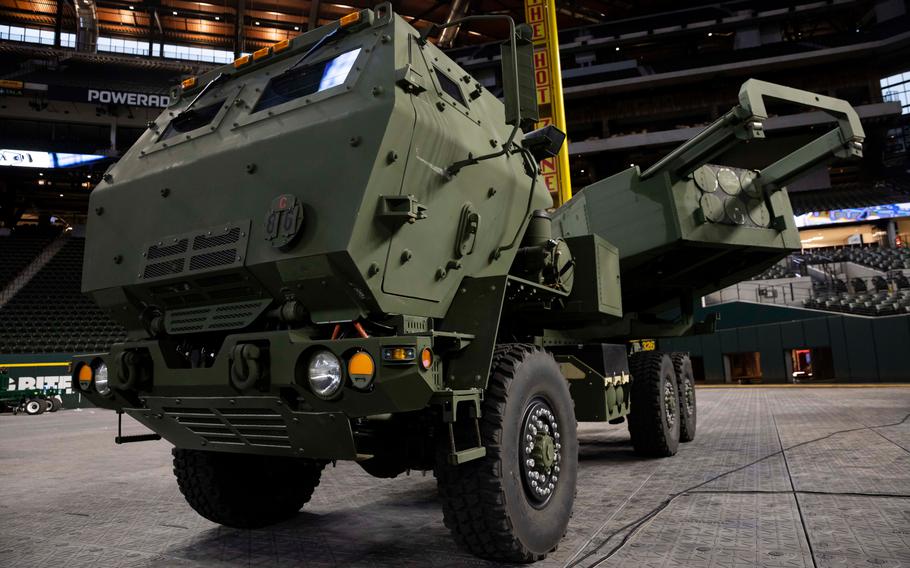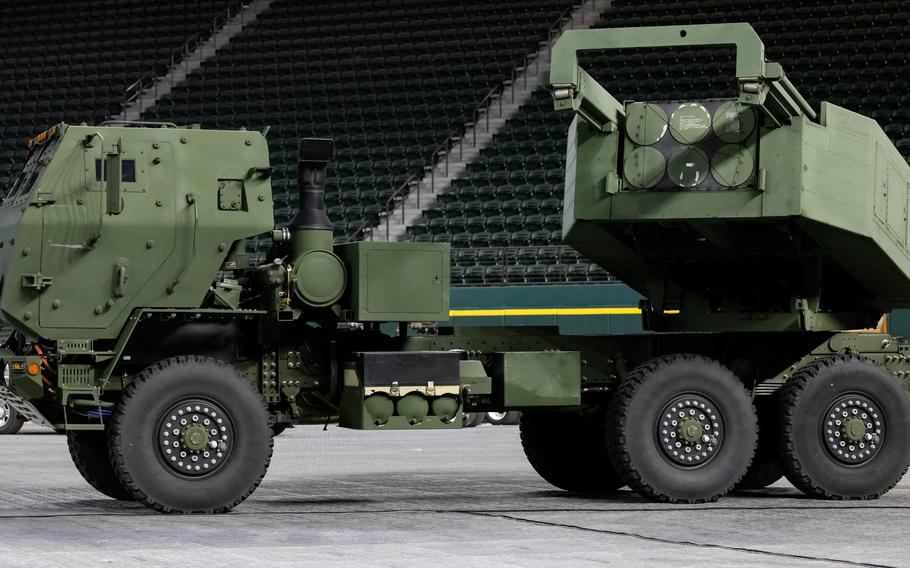
Lockheed is ramping up its production of HIMARS and other key weapons systems to meet rising demand by the U.S. and its allies. (Juan Figueroa, The Dallas Morning News/TNS)
WASHINGTON (Tribune News Service) — Ukraine’s military has used an agile missile system produced by Lockheed Martin to strike Russian forces, hampering their movement by taking out key bridges and laying waste to ammunition and supply depots.
Lockheed calls the M142 High Mobility Artillery Rocket System, a product of its Grand Prairie-based Missiles and Fire Control, the “most technically advanced, affordable and sustainable artillery solution.”
It has the ability to “shoot and scoot,” raining destruction on an enemy position and then swiftly relocating to avoid retaliatory attacks. The system has been a key part of the billions of dollars in military equipment that has been flowing from the U.S. to Ukraine, with the latest package announced last week by the Biden administration.
The reality of defense contracting is that tragic events, such as the fighting in Ukraine, can boost business. U.S. allies are lining up to buy systems such as HIMARS, and Lockheed is ramping up its production to meet that rising demand.
Overall, the company sees the potential for an additional $6 billion in revenue from Ukraine-related munitions sales over the next few years.
The company already is boosting its annual HIMARS production from 48 units a year to 60 on the way to an expected 96. The biggest impact will be at its primary production facilities in Arkansas.
But the increase also means a bright future for MFC headquarters in Grand Prairie, where about 4,000 employees support HIMARS and other systems.
“The broader demand signal does mean that there will be a robust and I think increasing job force in Grand Prairie and our other locations,” said Tim Cahill, who took over last year as executive vice president of MFC.
HIMARS is one of an array of high-tech Lockheed systems used by the U.S. and dozens of allies around the globe. Those precision-guided missiles and powerful rocket launchers are not typically household names, but HIMARS achieved a cult following last year as units from the U.S. helped Ukraine beat back invading Russian forces.
HIMARS has been the subject of a music video tribute and social media accounts heralding its use, such as “Is it HIMARS o’clock?” as Ukraine has used successful strikes to taunt its Russian adversaries.
“A little over a year ago if you would have used the term HIMARS, probably just about nobody you met, unless they were directly in the business, would even know what you were talking about,” Cahill said. “And now your relatives know, your family; you can ask just about anybody on the street and get a pretty good hit rate.”
Lockheed also partners with fellow defense contractor Raytheon on the tank-destroying Javelins that have helped Ukraine. And it produces the PAC-3 air defense used to down everything from cruise missiles to aircraft. Lockheed is boosting production of PAC-3 units to meet increased demand.
Cahill said Ukraine has demonstrated the general importance of precision strike capability, but also of air defenses.
“If you can keep the other guys’ air power at bay, that makes it a lot more effective for your systems to be able to strike back,” Cahill said.
Eastern European countries are particularly interested in bulking up their capabilities in the wake of Russia’s invasion, but Lockheed also is talking to countries such as Australia, India, Japan — and customers across the Middle East.

Lockheed Martin’s M142 High Mobility Artillery Rocket System, more commonly known as HIMARS, is a product of the company’s Grand Prairie-based Missiles and Fire Control, where about 4,000 people work on the launcher. This one was on display during a press event at Globe Life Field in Arlington in October 2022. (Juan Figueroa, The Dallas Morning News/TNS)
“Ukraine is on everybody’s mind regardless of where you are on the globe, and the lessons of preparing for a potential conflict with whoever you may be concerned about having to protect against is on everybody’s mind,” Cahill said.
The U.S. military was primarily focused on the kind of counter-terrorism operations central to Iraq and Afghanistan for two decades, but Russia’s invasion of Ukraine marks a return to competition between world powers, said Seth Jones, senior vice president at the Center for Strategic and International Studies.
That kind of conflict requires an industrial base that can crank out long-range missiles, air defense systems, battle tanks and other fighting vehicles that get ground up in the conflict.
“The war in Ukraine highlights unambiguously that a conventional war between major powers is an industrial war,” he said.
Jones wrote a recent report called “Empty Bins in a Wartime Environment” that found U.S. stores of certain key munitions are low given the situation in Ukraine and increased tensions with China.
Ramping up the production capacity for those munitions is important if the U.S. wants to deter Chinese aggression in a way similar to how it countered the Soviet Union during the Cold War.
“To do that you not only have to show that you’re willing to fight, there’s intent, but that you have the capabilities to do it,” Jones said. “In order to deter — and to fight if deterrence fails — you need a healthy industrial base.”
In simulations of a war with China, Jones wrote that U.S. supplies of certain long-range missiles produced by Lockheed would be quickly used up.
The Pentagon could move to making multi-year purchases of munitions. Traditionally, multi-year contracts have been used more for major programs such as fifth-generation fighter jets like the F-35 or ballistic submarines.
But the sharp increase in demand for munitions has the Pentagon considering a similar approach to those purchases. Cahill touted the potential benefits of going to multi-year buys for in-demand systems, allowing companies to buy in bulk and hedge against inflation.
Hundreds of companies contribute parts for those weapons — some of them small outfits that have to make difficult decisions when they don’t feel they can count on future business.
“That makes it a lot easier for companies to lean forward and invest,” Cahill said of multi-year orders.
It would mark a big change for the Defense Department, which has typically favored the flexibility of buying year-to-year so it can move money around more easily as events unfold.
But the evolving global situation has policymakers re-thinking that approach, and it’s a topic Congress is likely to examine during this year’s appropriations cycle.
“It’s definitely something that we wouldn’t ordinarily be talking about if it hadn’t been for the last year’s events,” Cahill said.
©2023 The Dallas Morning News.
Visit dallasnews.com.
Distributed by Tribune Content Agency, LLC.